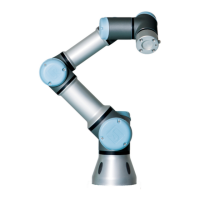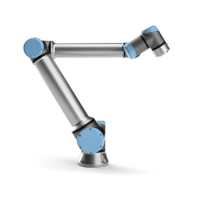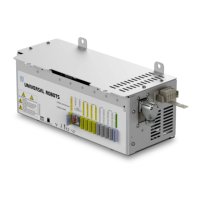2.4 Safety Modes
Worst Case
Limiting Safety
Function
Trueness Detection
Time
De-energizing
Time
Reaction Time
Joint position 1.15
◦
100 ms 1000 ms 1100 ms
Joint speed 1.15
◦
/s 250 ms 1000 ms 1250 ms
TCP position 20 mm 100 ms 1000 ms 1100 ms
TCP orientation 1.15
◦
100 ms 1000 ms 1100 ms
TCP speed 50
mm
/s 250 ms 1000 ms 1250 ms
TCP force 25 N 250 ms 1000 ms 1250 ms
Momentum 3
kg m
/s 250 ms 1000 ms 1250 ms
Power 10 W 250 ms 1000 ms 1250 ms
The system is considered de-energized when the 48 V bus voltage reaches an electrical potential be-
low 7.3 V. The de-energizing time is the time from a detection of an event until the system has been
de-energized.
WARNING:
There are two exceptions to the force limiting function that are impor-
tant to notice when designing the work cell for the robot. These are
illustrated in Figure 2.1. As the robot stretches out, the knee-joint ef-
fect can give high forces in the radial direction (away from the base),
but at the same time, low speeds. Similarly, the short leverage arm,
when the tool is close to the base and moving tangential (around) the
base, can cause high forces, but also at low speeds. Pinching haz-
ards can be avoided, for instance, by removing obstacles in these ar-
eas, placing the robot differently, or by using a combination of safety
planes and joint limits to remove the hazard by preventing the robot
moving into this region of its workspace.
WARNING:
If the robot is used in manual hand-guiding applications with linear
movements, the joint speed limit must be set to maximum 40 degrees
per second for the base and shoulder joints unless a risk assessment
shows that speeds above 40 degrees per second are acceptable. This
will prevent fast movements of the robot elbow near singularities.
2.4 Safety Modes
Normal and Reduced mode The safety system has two configurable safety modes: Normal and
Reduced. Safety limits can be configured for each of these two modes. Reduced mode is active when
the robot TCP is positioned beyond a Trigger Reduced mode plane or when triggered by a safety in-
put. Reduced mode can be triggered either by using a plane or by using an input.
Version 3.10
Copyright © 2009–2019 by Universal Robots A/S. All rights reserved.
I-15 UR3/CB3

